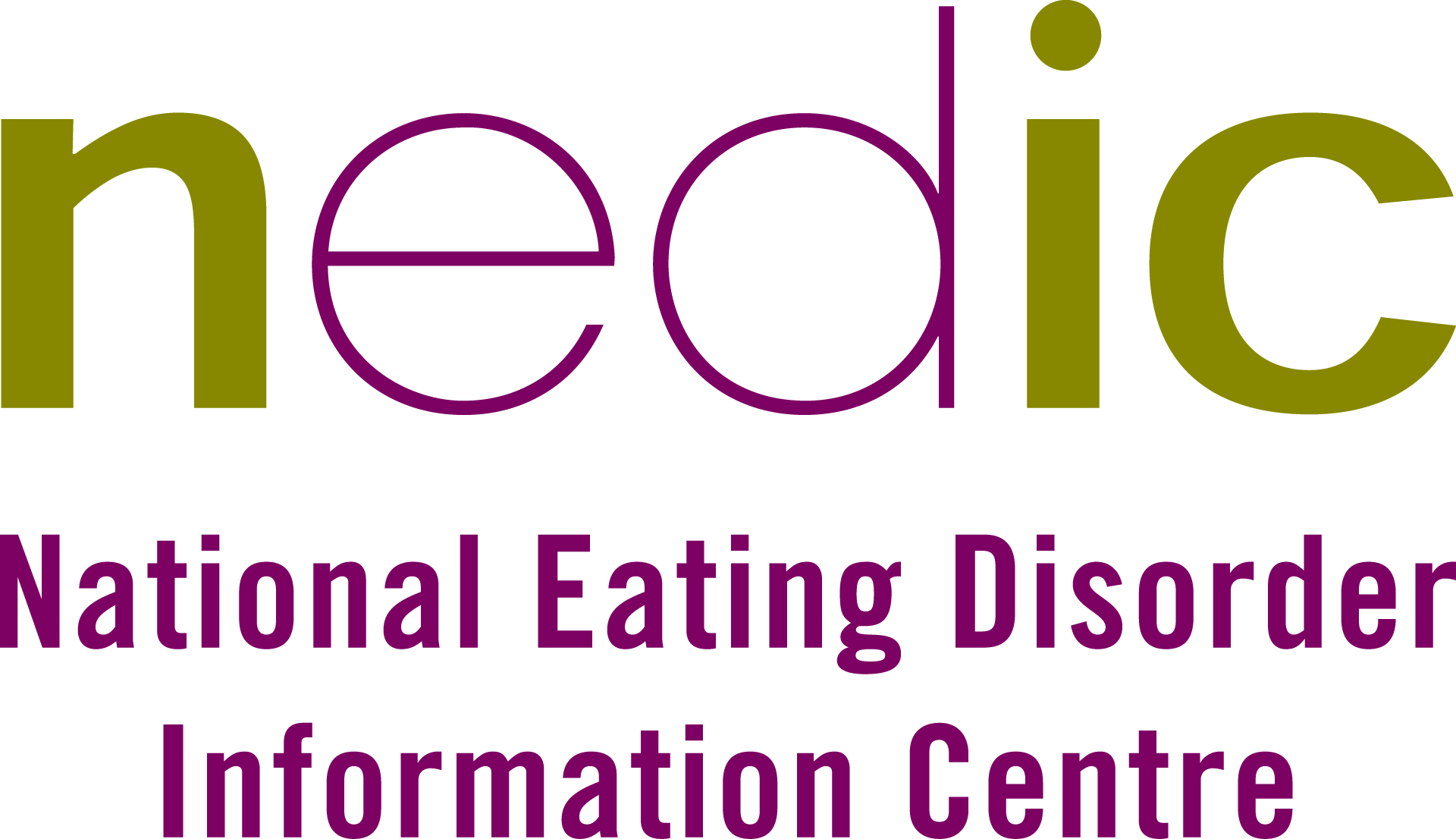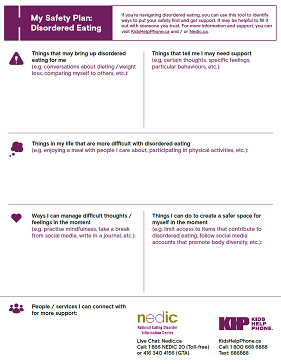
On this page
Throughout this article, we refer to “disordered eating.” You may have come across the term “eating disorders” before, and while the two terms may sound similar, there are actually differences.
The term eating disorders refers to a set of mental health conditions that can be diagnosed. They can only be diagnosed by a health-care professional. You can learn more about different types of eating disorders from NEDIC (National Eating Disorder Information Centre).
The term disordered eating refers to specific thoughts, particular behaviours and certain attitudes about food, eating and / or body image that can interfere with a person’s daily life. Examples may include:
Someone with an eating disorder may experience disordered eating thoughts, behaviours and attitudes, but not everyone that experiences disordered eating has an eating disorder. Regardless of whether you have a diagnosis for what you’re experiencing or not, you can learn ways to manage your thoughts, feelings and behaviours — and plan for your safety — so that you’re more familiar with what to do to take care of yourself / get support when you need it.
To learn more about disordered eating, you can tap this link, scroll down and select “Disordered eating” from NEDIC’s list of definitions.
If a person continues to experience symptoms of disordered eating over time, they may start to experience more intense and harmful thoughts, feelings and behaviours. For some people, disordered eating may be an early sign of an eating disorder. Eating disorders can lead to various physical health concerns (e.g. low heart rate, fainting, effects on growth, etc.). Recognizing when / how disordered eating affects your daily life and understanding what coping strategies / supports work best for you may help you manage disordered eating and reduce potential harm to your well-being. A safety plan can help you identify ways to cope and plan how to get support when you may need it.
Creating a safety plan ahead of time (e.g. when you’re feeling calm and in control of your thoughts, etc.) can help you understand yourself and what tools may be available to you for support when you’re navigating disordered eating. You may also find it worthwhile to ask people you trust to help you create your safety plan (e.g. a family / community member, professional counsellor, trained, volunteer crisis responder, youth group leader, Elder, etc.). The person(s) you trust may be able to offer perspective, provide suggestions and / or keep a copy of your safety plan for when you need it (if you’re comfortable with that).
It’s OK if your plan changes over time as you find coping strategies that work better for you, you discover new strategies or your situation changes. Your safety plan is unique to you and it’s OK if any prompts / examples offered in this article don’t apply to you. For your plan to be helpful when you’re experiencing disordered eating, we encourage you to make your plan as specific to you and your life as possible.
Download the PDF tool here.

Consider where you want to keep your safety plan so you can find it quickly when you need it. For example, you could keep / save it on a phone, tablet or computer (if you have access to one), in a notebook / journal or in places you may experience disordered eating thoughts / behaviours (e.g. in a kitchen, in a bathroom, by a scale, etc.).
If you’ve ever experienced disordered eating before, you may be aware of some familiar patterns, situations and / or events in which you may start to notice disordered eating thoughts, feelings or behaviours (e.g. comments by others about your body and / or eating habits, exposure to content that shames certain body types, etc.). Understanding what stressors or events can contribute to thoughts / feelings of insecurity about your body and other difficult emotions could help you recognize when you may need to use your coping strategies or get support.
It may be helpful to think about the ways disordered eating is affecting your daily life. Try thinking about all of the things that make you happy or hold meaning and importance to you. Consider how those things are potentially more challenging with disordered eating thoughts, feelings and behaviours. For example, participating in physical activities (e.g. your favourite sport / game, dancing, exercising, riding a bike, etc.) may be more challenging if your body isn’t well nourished. You may also find it more difficult to enjoy a spontaneous meal with someone you care about. These are just some examples of the ways disordered eating could affect your life. Your experiences are unique and you may identify other ways in which your thoughts, feelings and behaviours are affecting things in your life. Understanding where your values and actions don’t match may help you consider new coping strategies / actions that better fit with what matters to you.
It can also be helpful to identify warning signs that you may engage in disordered eating. Warning signs can be changes in your thoughts (e.g. thinking “I’m not good enough,” etc.), feelings (e.g. feeling worried, insecure, overwhelmed, etc.), behaviours (e.g. avoiding social gatherings that involve food, etc.) and / or bodily sensations (e.g. feeling hungry, etc.). It can also be helpful to consider what changes other people around you may notice, and how they can know when and how to offer support. Not all changes in your thoughts, feelings, behaviours and bodily sensations are signals that you’re engaging / may engage in harmful actions. But by recognizing your warning signs, you might know when it may be helpful to connect with your supports / use your coping strategies.
There are things you can do to take care of yourself, your body and your eating habits if you’re navigating disordered eating. Can you remember what’s worked for you in the past? It can be helpful to think about things you’ve learned / tried before that you can either try on your own, or with people you trust, to manage difficult thoughts / feelings in the moment. You may find it useful to have a list of go-to strategies you can choose from when you begin to notice your warning signs or you’re experiencing disordered eating. If one strategy isn’t feeling helpful in the moment, you can try another. Having a list to pick and choose from may help you to try a variety of strategies until you find the one you need. Here are a few ideas to consider that may help you cope with disordered eating:
You can learn about more strategies for coping with disordered eating from NEDIC.
In addition to using your coping strategies to manage difficult thoughts / feelings, you may consider ways you can create safer spaces wherever you are.
It may be helpful to come up with a plan with someone you trust for how you can make your living space safer when you’re coping with disordered eating. This may include asking someone to limit your access to items that could be potentially harmful or contribute to disordered eating (e.g. substances used to purge, scales, etc.).
You may also consider how the people you spend your time with affect the way you feel. Notice how you feel after having social interactions with people in your life. Are there ways you can spend more time with people who you feel uplifted by, people who eat / enjoy a variety of different foods, nourish themselves when they’re hungry, accept their body as it is, etc.?
If being in your physical space feels unsafe, are there places you can spend time outside of your current space more regularly (e.g. a community centre, friend’s house, place of worship, library, youth centre, etc.)? You can try researching what community resources may be available nearest your location to help you discover potentially safer spaces.
If you’re spending time on the internet, you may also consider how you can create a safer virtual space for yourself. The types of media you engage with can affect your thoughts / feelings about your body, the food you eat and the choices you make. You might consider how you could remove / hide unhelpful content to create a safer online space for yourself. For example:
You may instead follow accounts that celebrate the diversity of human experiences, share positive or neutral messaging about body image or share posts that get you excited, inspired, smiling or reflective. If you find yourself automatically opening social media apps even when you feel unhappy while on them, you can consider putting the apps in a subfolder on a separate page of your device, setting screen time limits for your apps or temporarily deactivating your account(s) to explore how it feels.
It’s OK if you feel unsure, nervous, overwhelmed or any other emotion at the thought of sharing your experiences with the people in your life. And you don’t have to navigate these feelings / experiences on your own. If you find it difficult to manage your thoughts, feelings and / or behaviours, it can be helpful to know whom you can connect with for help when you need it. You can do this by mapping out your community of support and creating a list of people / services you can connect with when you’re finding it hard to cope on your own. Consider people who you feel comfortable opening up to whom you trust and feel respected around. An example of a trusted person may be a family / community member, teacher, person from your place of worship, Elder, friend, youth group leader, etc.
In your safety plan, you can even get specific with the role each person in your list can play (e.g. “this person is a great listener,” “this person helps distract me,” “this person can give me a ride to appointments,” etc.). You can also consider alternatives ahead of time in case your contacts aren’t available. You may want to consider how you can connect with each person (e.g. call / text, chat online, walk to their house, write them a letter, etc.). If you’re feeling nervous about connecting for support, you can prepare ahead of time by exploring how to have a tough conversation.
Not sure who to contact? You can use NEDIC’s Service Provider Directory to search for support services that may be available nearest your area. Maybe connecting with a professional anonymously feels the safest for you — that’s OK. You can do this by contacting Kids Help Phone’s professional counsellors or NEDIC's support workers and trained volunteers.
“Thank you so much for listening and not dismissing my concerns. You actually understand and helped so much with feeling like I'm not alone and that I'm not wrong for asking for help. I really do appreciate all your time tonight and feel a lot more hopeful now that there's a plan.”
– person contacting the National Eating Disorder Information Centre
More information, tools and coping strategies